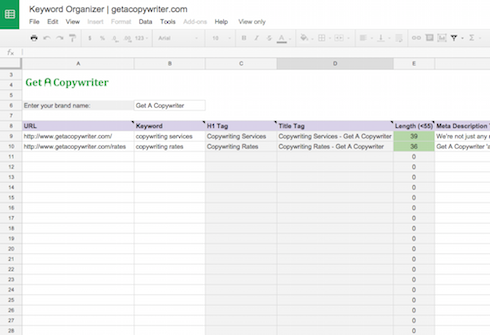In the constant battle for traffic, leads, shares, and sales, many marketers forget to pay attention to one key thing:
Trends.
As a brand, you need to constantly innovate new ways to market to your audience. People become desensitized to the same messages being conveyed over and over in a similar way.
That’s where seasonal content can bring your business back into the spotlight.
Seasonal content marketing is a great way to add variety and capture (or recapture) your buyers’ attention.
It’s content that’s either themed around that particular season or helps your audience take more advantage of it.
With big retail brands, you see time-specific marketing in the form of “Fall Sales!” and “Holiday Savings!”
In content marketing, you may see it in the form of seasonally themed infographics or helpful guides related to that time of the year.
But what makes it effective?
First, you get to capitalize on B2C buyer mania:
- Black Friday
- Christmas
- 4th of July sales
- Viral branded content marketing campaigns
Buyers plan for these seasons and are ready to pull out their wallets. The goal of seasonal content marketing is to make sure your business is the one they think of first when their wallets come out.
Next, you also get to capitalize on B2B events, like different quarters and bank holidays.
Seasonal content is often more shareable than regular content, which boosts brand awareness. And the season is already on their minds so your content enters naturally into their lives.
Learn how to dominate Q4 with a fresh seasonal content marketing campaign
Click to tweet
The two main kinds of seasonal content
The “seasons” aren’t limited to winter, summer, fall, and spring.
In fact, just about any trend related to your business can be considered a season.
There are two main kinds of seasonal content marketing:
- Time-based content (the regular seasons of the year)
- Event-based content (Thanksgiving, Memorial Day, bank holidays, etc.)
There can be a lot of overlap between these types, but if you happen to be caught in both seasons, you’ll need to determine whether you’re targeting one or both.
Examples of seasonal content
Here’s the key with seasonal content marketing:
You should make your product or service the centerpiece of the campaign, not the season.
The season is merely a vehicle to change up your marketing and make it more shareable.
For B2C companies, here are some great examples:
1. Gift guides
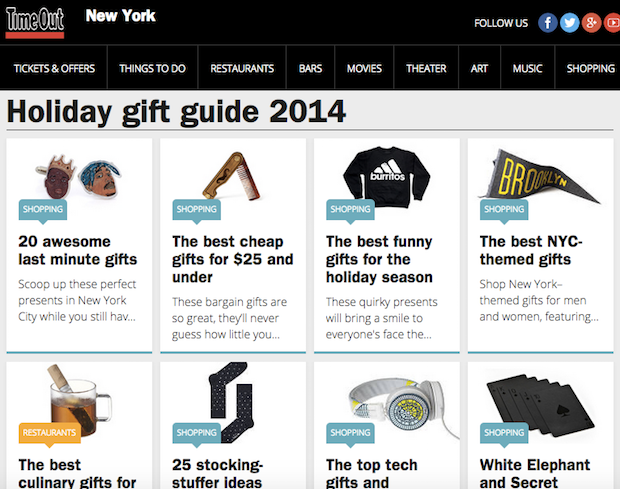
2. Seasonally themed infographics

3. Holiday or seasonal recipes

Here are some ideas for B2B companies:
1. Business strategies that work best for that season
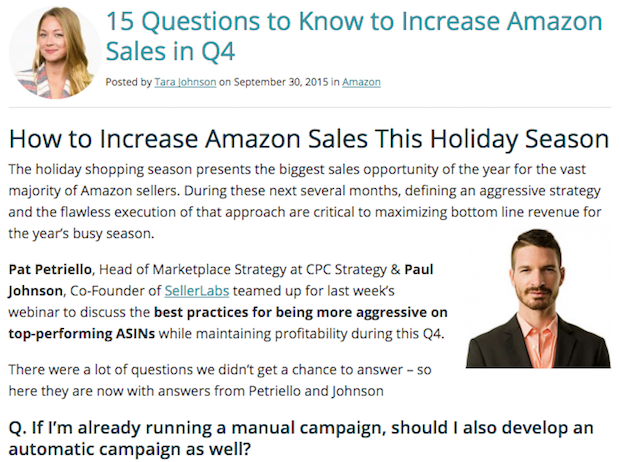
2. Product guides to get a leg up on your competition
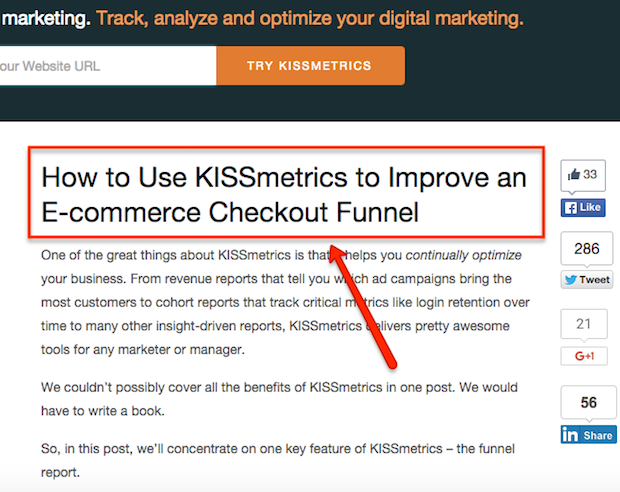
3. A great example of B2B seasonal content from Personnel Today
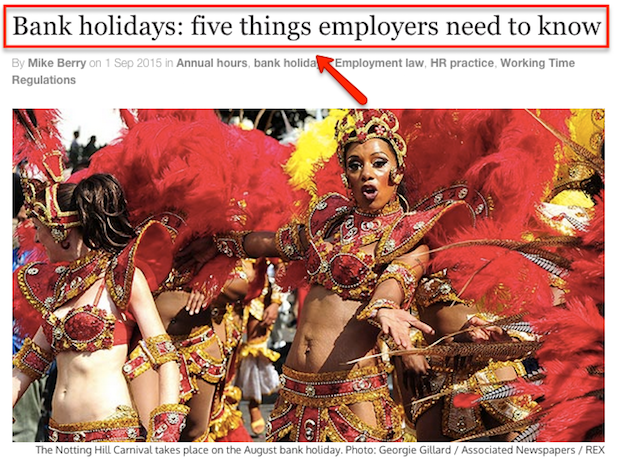
Keyword research for seasonal content marketing
By definition, seasons are trends.You can be sure to see these trends reflected in both monthly searches and search engine traffic.
Even though the odds of most businesses creating content and getting it ranked that same season are low, you should still base your content around these keywords for two reasons:
- You know those topics are popular for that season and are more likely to get shared
- You might end up ranking for them next season
Here’s how to find seasonal keywords:
First, head over to the Google Keyword Planner. Then type in a keyword related to your niche:

Scroll down and click on the “Keyword Ideas” tab and hover over the “trends” icon next to your keyword.
This will show you a graph of its monthly searches over the past year:
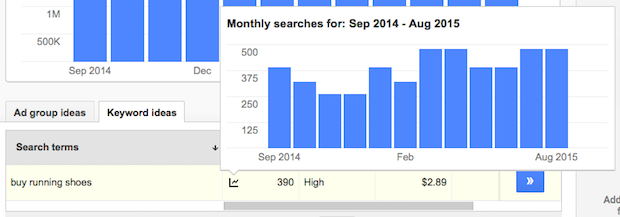
As you can see, searches for the keyword “buy running shoes” peak around the beginning of the year (New Year’s resolutions) through summer (nice weather) and drop back down around Thanksgiving and Christmas.
If I was a shoe retailer, I might run seasonal content marketing campaigns about “how to buy the right running shoes” starting in January. I would also publish content about how to follow through on a New Year’s resolution (and maybe even some real life case studies!)
Since people tend to hit the gym and exercise before summer, I would give that campaign a boost around April—May.
Then I might tone it down and finish off the campaign once September rolls around, because people aren’t as interested in buying running shoes.
If you want to know exactly what’s trending at any moment, Google Trends is a great resource.
Simply type in a topic you’d like to get some data on, and Google will tell you what’s trending on the Internet at that particular time.
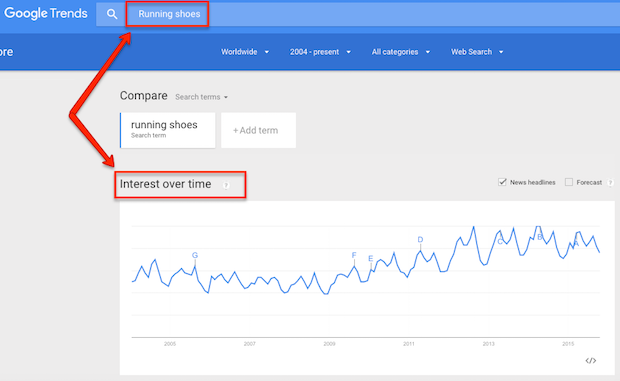
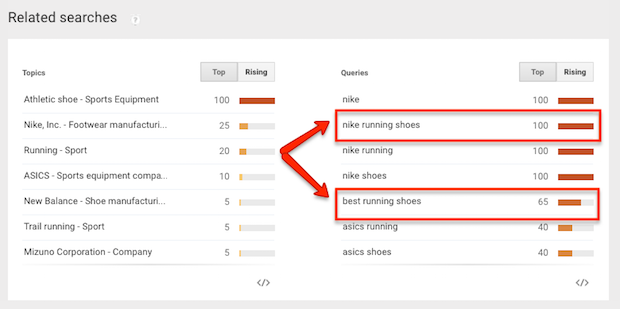
You can then use this data to send out content that’s extremely relevant to that time period.
Timing your campaigns correctly
Timing is critical in seasonal content marketing.
To maximize your results, your goal is to get two things right:
- The start of your campaign
- What types of content you publish/promote and when
You should start your campaigns just before the peak of the season. This makes sure you’re one of the leaders, rather than following in everyone else’s footsteps.
For example, according to SiteProNews you should be starting your Christmas campaigns in early October. This is when customer demand begins to rise, as people buy gifts in preparation for the holiday season.
Starting promotions before your competitors also helps your company stand out.

However, if you start too early, your campaign might fizzle out before interest really starts to climb. So start slowly and gradually push out your better content.
This builds anticipation and makes sure your best stuff isn’t falling on deaf ears.
Anticipate the Seasons and Prepare
Many businesses are subject to consumer buying trends. This is where you get “slow” seasons and “busy” seasons.
Especially for these businesses (but not solely for them), it’s important to take advantage of slow times and prepare for the busiest times of the year.
First, you should know exactly when your busiest seasons start. Mark them on the calendar and make sure everyone at your company is aware.
Then, during your down seasons, research the possible buying trends for each busy season.
Use Google Trends to see what topics in your industry were trending last season. This will give you insight into what types of content will perform best.
If you’re in the middle of the season, use Google Trends to find out what’s trending right now.
Then, brainstorm how you can make your content unique. Look at what your competitors published last season and see how you can improve upon it:
- Can you add better graphics?
- Can you make it longer and more detailed?
- Can you include additional resources that your audience would find valuable?
- Can you incorporate viral components, like hashtags, that your competitors tend to ignore?
Characteristics like these can help your content stand out.
To plan your content, you should also establish an editorial calendar. This will keep you and your team on track with planning, creating, publishing, and promoting all of your seasonal content:
This WordPress plugin makes it really easy:
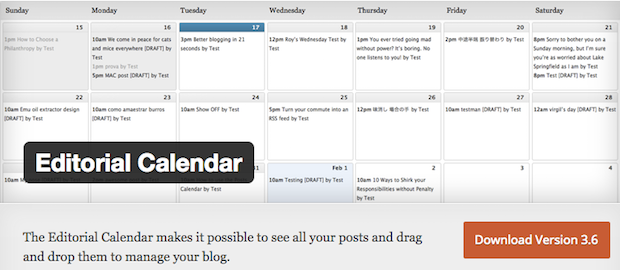
Finally, identify the key business objectives you want to achieve. These can be, but are not limited to, the following:
- Social shares
- Traffic
- Email subscribers
- Lead magnet downloads
- “Add to Cart” clicks
- Sales
When next season is almost upon you, analyze how your last campaign went and what you can do better this time.
Content promotion considerations
As with any content marketing campaign, content promotion is King. Without promoting your content to the right audience, it won’t do much for your business (no matter how good it is).
But when promoting seasonal content, don’t forget this notion:
Seasonal content inherently involves temporary interest.
It’s best to focus on social media and outreach campaigns that you can turn on and off at the drop of a hat. This will maximize your reach and ROI.
You should be able to push out your content quickly, effectively, and to the right audience.
Here are a few methods I suggest:
- Facebook ads
- Google Adwords
- Paid Twitter promotions
Each of these tactics act like a traffic faucet that you can turn on or off whenever you want. You can even control how much exposure your content gets, based on the monetary investment you put in.
For example, to prepare for Black Friday and Cyber Monday (and in between both days) Dell used Facebook ads to increase sales 150% through paid social advertising and get a 2.16 margin of return on their ad spend:

They also managed to beat their original revenue goal by a solid 8%.
(Source: Sprinklr)
These types of paid advertising strategies give you the ability to push out your content quickly and reach the right people at the best possible time.
Drop “Time Bombs” into your content
“Time bombs” are references to current events. You can throw these into your content or sparse them around your campaign as articles themselves.
An example in the marketing space could be when SEOmoz rebranded to Moz. Referencing an event like this, or basing some of your content around it, could help your content get more exposure.
In the B2C realm, you could reference pop culture events, like the release of Justin Bieber’s Christmas album:
Time bombs give your audience hooks they can immediately connect with.
This could be referencing something from pop culture, a trending story in the business world, or the outcome of a sporting event.
Whichever you choose, time bombs can make your content more relevant and more shareable.
Match the season to your brand
The season shouldn’t decide how your brand is portrayed. It should act as a vehicle to get your brand’s message out there in a different and unique way.
In other words, don’t let it take over your message.
B&Q, a British home improvement and DIY retailer, did this beautifully with their #ChristmasUnleashed campaign.

This campaign was seasonally themed, but continued to convey their core message of “unleashing the DIY expert within you.”
Remember your “Why” and your business’s core values.
Remember how your business ultimately helps people, and send that same message in ways that fit in naturally with the sentiments of the season.
What does your business offer that’s relevant to that particular time? It’s not just about your products and services, but about connecting to the very real emotions and situations your audience experiences.
Match the season to your brand, not your brand to the season #SeasonalContent
Click to tweet
Wrapping it up
Seasonal content marketing can be a powerful way to take advantage of people’s natural buying trends.
But rather than inundate your audience with “Holiday Savings,” you enter their lives on the same wavelength.
Just remember to:
- Base your content around keywords that you know are trending for that season
- Time your campaigns just before the peak of each season
- Prepare during your slow times
- Use paid promotion to get your content out quickly and effectively
- And match the season to your brand
How do you plan to use seasonal content? Let me know in the comments below.
I purposefully butcher the occasional grammatical rule… it’s the rebel in me, I suppose. In many cases, the strategically placed off-phrase can enhance your writing; plus, I’m from Texas where the “language” isn’t exactly proper all the time.
Y’all know bout that, dontcha!?
It’s cute and funny to sometimes throw the rules out the window, but there are a few instances in writing grammatically correct content where breaking the rules just make the Grammar Police attack your comment section…

Please, review the proper application of a “your,” a “there,” and a “to.”
Ohhhh, people. This one just happens to be my biggest pet peeve.
Your: Shows possession.
You’re: A contraction which combines “you” and “are.”
“You’re such a talented writer, we should submit your status updates to Failbook.”
—
There: A location.
Their: Shows possession by more than one.
They’re: Another contraction combining “they” and “are.”
“They’re going to their couples back-waxing appointment over there in the strip mall.”
—
To: Put simply, it indicates a destination or intent.
Too: As well as or in addition to.
Two: 2
“I am going to get a tattoo, too. I think two lips on my rear end would be an asset.”

Take a compliment.
There is a very distinctive difference between a complement and a compliment.
If your significant other spent hours getting ready to go to a party, remember to compliment her looks, and don’t suggest a pair of pants might complement her derriere better than that miniskirt.
Don’t lose sight of your loose objective.
You can lose a game, lose your keys, and lose your mind. These could be caused by a loose defense, too much loose change and junk in your bag, or your loose morals.
Don’t be anxious.
I have a friend who likes to use anxious instead of excited. It could be a Texas thing, there are a lot of y’all in this area who like this one… but it still doesn’t make it right.
Anxious indicates fear. You can be anxious about a dentist appointment or a job interview, but you probably shouldn’t be anxious to see your long-lost best friend.
To cause and affect…
Affect is something that you (or any noun) can actually do to another noun. The result of this is the effect.
Clear as mud? Since grammar checkers such as Grammarly and Ginger are not always a failproof way to look for these errors, we suggest using the old fashioned “Control F” (or Command F on a Mac) and search for those words within the text. Give your copywriter, editor, or publisher instructions on checking for errors with those words, and you’ll avoid distracting your reader with silly grade-school grammar mistakes.
I can relate to those techie-scared small-business owners out there who are just glad they finally made that HUGE leap into modern times by getting a website.
My photography business skated along for years off-line… I relied on business cards and word-of mouth to attract customers. The ironic part of it was that I’ve been a writer for years, and even had a personal blog that I used as a journal.
It just didn’t occur to me to combine the two…
It doesn’t matter what your business is, a blog can put you out there in a way that traditional advertising can’t.

After several years of entertaining my mutually-exclusive hobbies (and writing articles for other people), it occurred to me that I could use each of those skills I’d played around with to help each other.
And thus, I finally modernized and got a website for my photo business, created a fan-page on Facebook, and started blogging about the whole thing.
What I found was that the blog actually attracted people that normal advertising didn’t. People would show up looking for photography tips, and wind up browsing the website I mentioned once somewhere in the post.
Each new blog post also gave me a link to use as a status update on Facebook… I was beginning to tie everything together.
I discovered that a blog doesn’t necessarily have to be perfectly honed to fit into a certain niche.
For a while, I kept separate blogs, thinking I needed to keep everything in its proper category… I didn’t want to bore my photography clients with random stories about my kids, or tales of my loopy cowdog getting scared of a salamander. I also didn’t want my humor-seeking blog followers to get fed up with my “I took another photo” posts.
After a few months (and a few misplaced posts), I realized that the blogs were all me… in one form or another. It began to seem pointless to keep separating things, and I kept getting stuck when I had a post that merged the two topics… such as a great story about my minions (my kids) interrupting a photo shoot by popping into the frame with their goofiest expressions.
I took another plunge (hey, I don’t like change) and combined the two. I’d blog about photography when the mood struck, and post all my silly stories in-between.
To my surprise, I began to gain readers like never before! Turns out, people liked the variety and would visit more because of it. Those looking for photography-related content could still find those things (thank WordPress for categories and tags), and those looking for random life-moments still had those… and some stumbled across photos they liked and became clients!
I learned a few tricks to make everything relevant.

Even though everything on my blog is categorized somehow, I discovered that I could advertise my photography services just about everywhere… without being pushy or annoying my readers.
I started adding photos to most posts, even those not about photography. A small link to my photo website accompanies each picture, and those who just want to read aren’t interrupted. Those who like the pictures can click for more.
A small mention of picture-taking can be turned into a hyper-link easily, that will take people to more photo-related posts. Linking to previously published posts takes them to even more places where my photos, stories, and contact info are prominent.
See, you don’t have to specifically blog about what you’re selling… write about something fun and semi-related. That one small link is all you need.
Any business can do this!
Selling beef jerky? You can blog about cows, health food, great snacks for vacations, or spices… and manage to keep your readers entertained without straying completely off-topic.
Trying to launch a massage service? There are plenty of topics you can entertain readers with, including benefits of massage, health, history, and news in the industry.
There was a blog post about toilet paper that went viral a couple weeks ago, so rest assured that anything can be made interesting enough to blog about!
Don’t forget to connect everything!

Again, it doesn’t matter what your business is or what you blog about. Just make sure you connect the two.
Mention your business in your blog, and mention your blog posts on your website. Use Facebook, Twitter, and other social media to attract people to both.
Just to make a point, here would be a great place to say something along the lines of “would you like to see some great photos? Check out my photography website at…”
According to a Netcraft survey completed in March of 2012, there are over 644 million active websites globally.
What this means is that the competition for readers is fierce. The pool of likely candidates in any given search is in the millions. At which point, your site will get a few seconds of consideration – as the searcher decides if they want to click on yours or the next one. Then, if the do choose you, you get another few seconds to make an impression before they go back to the original search and try another.
This all happens in a matter of a few minutes. It seems unjust, with all of the heart and soul you put into your business and in creating a website that expresses who you are and what your business represents. It almost feels like a personal rejection.
It’s not. Don’t take it personally. This is the way business is done in a globally connected world. To succeed, you need to speak to your customer’s only – not everyone who does a Google search. Your content must address their unique questions, issues and concerns. It must be presented in a manner that eliminates everyone else form the equation and establishes you as the authority on the subject and the answer to their need. You have to do all of the heavy lifting – think of everything the searcher might look for and have it ready for them when they arrive. To survive, it has to be easy on the client or they will move on in a hurry.

Whether is be a blog or a website, follow these guidelines for creating web content that works as hard as you:
1. Know Your Audience – before your write a single word, know exactly whom you are talking to. Visualize the “ideal” client and clarify their background, needs, demands, challenges and questions as they pertain to your product or service. Then write everything as if you were speaking directly to this person.
2. Keep it Conversational – Everything you write should be with conversational, informative, and friendly tone. Remember, you are the expert, sharing your wisdom with inquiring minds. Write as if your customer is right in front of you, asking your advice regarding their needs.
3. Client Needs Come First – Visitors to your website have come looking for information, knowledge and answers. Your content should be benefit driven from your client’s perspective.
4. K.I.S.S. (Keep It Simple Stupid) – Don’t assume that your visitor’s have any particular knowledge of your business or product. Content should use words and phrases that are familiar to your potential customer and avoid industry jargon only you understand. Write one idea per paragraph and give them the answer early – then expand on it.
5. Avoid the Hype – Avoid the use of superlatives (the best, the most effective, etc.) when describing your products and services. This should not be an advertisement. They want to get your input then make a decision for themselves – no pressure, no hard sell.
6. Be Relevant – Everything should have meaning and significance to your reader – they want what they came for and care little about anything else. This is also significant regarding your search engine results. Every month Google bots crawl all known websites – cataloging, filing and organizing key words and phrases. This information is used when a user types in a Google search – these keywords are scanned for relevance and used to serve up the “best” possible results to answer the searchers request. Your content should be communicated in a concise manner, including as many keywords as possibly, yet still written for a reader. Don’t just string together keywords – this might generate a search results but it will gain you no readers.

There seems to be a dual challenge – to be found via an Internet and to engage the reader in hopes of building a relationship. These two outcomes are not at odds with each other – nor are they easily accomplished. Your content tells people who you are and is a tremendous means way to help clients find you and to building a relationship with them. By following these simply guidelines you will be well on your way to building a site that works as hard as you do to grow your business.
Does your team need a solution to clumsy attachments, multiple copies on Dropbox, or a simplified keyword organizational tool that clients, marketers, and developers can access?
The concept of this spreadsheet is not new, but the fact that our keyword organizer document is now available via Google Docs rather than Excel adds a little something extra for our tribe of followers.
An easy-access keyword organizer can get your whole team on the same page, quickly. Every member of the digital marketing team, from the SEO guru to the PR team, to the developers, and the copywriting team can view website keyword structure and implement design and copy creation without error. For those of you who are Excel junkies or conspiracy theorists about the Google Drive, you may download it and change the format and the storage location.
Ready?
Make a copy of our Keyword Organizer sheet, and off you go!
Need some tips on using the organizer? No problem!
- Make a copy of the spreadsheet.
- Enter the urls and the keywords associated with it, and your brand name. The H1 and Title tag will automatically populate. Create a description tag.
- The cells following the title tag and the description tag will turn green if you’ve stayed within character count guidelines, and will turn red if you’ve exceeded those guidelines. Formulas incorporate the latest recommendations based on studies by Moz and Screaming Frog.
- If the auto-populated version doesn’t “speak English”, change it so that it does. Tags should speak to people, not just search engines.
Free Google Doc keyword organizer and tag character counter from @getacopywriter
Click to tweet
Additional info:
- Looking for additional information on semantic keywords, contextual and conversational search? Search Metrics offers a case study on the Hummingbird algorithm and how it has affected SERPs, check it out!
- Keyword Cannibalization. YES, your keywords can eat each other. It’s a nasty visual, but luckily, LunaMetrics gives an overview of this mistake in their blog, along with some other helpful keyword tips.
- Keyword tools & keyword organizers go together like peanut butter and jelly. Giddy up.
